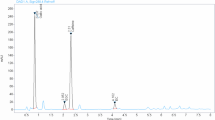Abstract
Herbs and minerals have been used in clinical dermatology for hundreds of years and herbal ingredients are becoming increasingly popular with the public in treatment of various dermatological conditions characterised by inflammation and pruritus. The aim of this study was to compare the efficacy of traditional topical therapeutic agents with a moderate potency topical glucocorticoid on experimental contact dermatitis and contact urticaria. The effects of ichthammol 10% pet, zinc oxide 20% pet, camphor 20% pet, levomenthol 10% pet, tea tree oil 20 or 50% and clobetason butyrate 0.05% ointment were studied in the following experimental models: elicitation of allergic contact dermatitis to nickel, irritant contact dermatitis to benzalkonium chloride, and in immediate reactions to histamine and benzoic acid (non-immunological contact utricaria) respectively. Delayed reactions were evaluated using a clinical scoring system and immediate reactions were estimated by planimetry. Histamine-induced pruritus was evaluated using VAS. Tea tree oil reduced allergic contact dermatitis by 40.5% (p = 0.003), zinc oxide by 17.4% (p = 0.04) and clobetason butyrate by 23.5% (p = 0.01). Zinc oxide reduced histamine induced flare by 18.5% (p = 0.01), ichthammol by 19.2% (p = 0.02) and clobetason butyrate by 44.1% (p = 0.02). Irritant contact dermatitis and non-immunological contact urticaria were not influenced by the pre-treatments. Pruritus induced by histamine also remained unchanged. In conclusion, tea tree oil seems to be a more effective anti-eczematic agent than zinc oxide and clobetasone butyrate, while clobetasone butyrate is superior to both ichthammol and zinc oxide in topical treatment of urticarial reactions.


Similar content being viewed by others
References
Bedi MK, Shenefelt PD (2002) Herbal therapy in dermatology. Arch Dermatol 2:232–242
Brand C, Grimbaldeston MA, Gamble JR, Drew J, Finlay-Jones JJ, Hart PH (2002) Tea tree oil reduces the swelling associated with the efferent phase of a contact hypersensitivity response. Inflamm Res 51:236–244
Carson CF, Hammer KA, Riley TV (2006) Melaleuca alternifolia (Tea Tree) oil: a review of antimicrobial and other medicinal properties. Clin Microbiol Rev 19:50–62
Fregert S (1974) Patch testing. In: Fregert S (ed) Manual of contact dermatitis. Munksgaard, Copenhagen, p 53
Khalil Z, Pearce AL, Satkunanathan N, Storer E, Finlay-Jones JJ, Hart PH (2004) Regulation of wheal and flare by tea tree oil: complementary human and rodent studies. Invest Dermatol 123:683–690
Koh KJ, Pearce AL, Marshman G, Finlay-Jones JJ, Hart PH (2002) Tea tree oil reduces histamine-induced skin inflammation. Br J Dermatol 147:1212–1217
Pearce AL, Finlay-Jones JJ, Hart PH (2005) Reduction of nickel-induced contact hypersensitivity reactions by topical tea tree oil in humans. Inflamm Res 54:22–30
Ventura MT, Viola M, Calogiuri G, Gaeta F, Pesole O, Romano A (2006) Hypersensitivity reactions to complementary and alternative medicine products. Curr Pharm Des 12:3393–3399
Wahlberg JE (1983) Assessment of skin irritancy: measurement of skin fold thickness. Contact Dermatitis 9:21–26
Wallengren J, Badendick K, Sundler F, Håkanson R, Zander E (1995) Innervation of the skin of the forearm in diabetic patients: relation to nerve function. Acta Derm Venereol 75:37–42
Wallengren J (2000) Dual effects of CGRP-antagonist on allergic contact dermatitis in human skin. Contact Dermatitis 43:137–143
Wallengren J, Håkanson R, Andren Sandberg Å (1992) Physiological factors influencing the SP-evoked flare and wheal in human skin. Adv Pain Res Ther 20:63–69
Welsh AL (1957) Lotions. In: Welsh AL (ed) The dermatologists handbook. American lecture series. Blackwell, Oxford, pp 42–44, 61
Acknowledgments
Technical assistance of Elsa Larsson and Inger Nordgren is greatfully acknowledged. The study was supported by The Welander and Finsen Foundation and The Asthma and Allergy Foundation. The author declares that she has no conflict of interest.
Author information
Authors and Affiliations
Corresponding author
Rights and permissions
About this article
Cite this article
Wallengren, J. Tea tree oil attenuates experimental contact dermatitis. Arch Dermatol Res 303, 333–338 (2011). https://doi.org/10.1007/s00403-010-1083-y
Received:
Revised:
Accepted:
Published:
Issue Date:
DOI: https://doi.org/10.1007/s00403-010-1083-y




